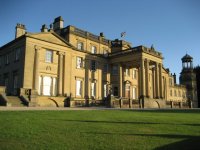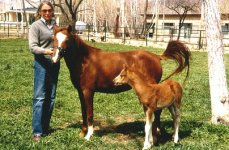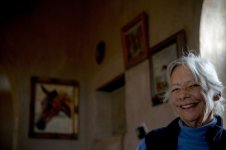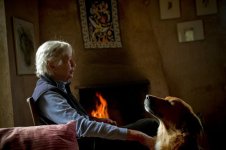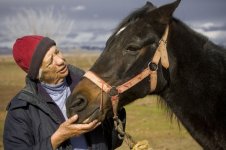Louise Firouz, who died on May 25 aged 74, is credited with rediscovering what she called the "Caspian" horse, thought to have been long extinct until she came across it in a remote corner of Iran in 1965; she believed the breed to have been the ancestor of the Arab.
Although American-born, Louise Firouz made Iran her home for the last 50 years of her life, electing to remain there even after the revolution of 1979 and during the difficult years of the war with Iraq. While she could occasionally be found at diplomatic parties in the capital, Teheran, she was happier at her home in the north-east of the country, surrounded by her dogs and horses.
She was born Louise Elizabeth Laylin on Christmas Eve 1933 in Washington DC, the daughter of a lawyer who had a farm at Great Falls, Virginia; it was there that Louise discovered her love of animals, although she was forced to abandon her dream of becoming a vet after failing her physics exam.
Instead she read Classics and English at Cornell University, as part of her course spending a year at the American University in Beirut. While in Lebanon she visited Iran, where she met Narcy Firouz, an Iranian aristocrat related to the Qajar dynasty who had trained as a civil engineer in the United States. They married in 1957 and went to live in Iran.
There Louise Firouz, an accomplished horsewoman, set up the Norouzabad Equestrian Centre, offering riding to children in Teheran. It was the difficulty of finding appropriate mounts for the smaller children that caused her to visit, in 1965, a remote area in the north of the country near the Caspian Sea, where, it was said, a small, narrow type of pony could be found.
This "pony" turned out to be what is now believed to be the forerunner of the Arab, and had been thought to have been extinct for more than a millenium.
A small, narrow animal, standing approximately 11.2 hands, it has the structure, gait and temperament of a horse rather than of a pony; although light-framed, it is nevertheless strong, elegant and fast, and capable of considerable agility. Louise Firouz became fascinated by the breed, which she called the Caspian. She traced its ancestry back to 3000 BC, and claimed to have identified it on the seal of Darius the Great in 500 BC.
She also gathered together enough of the animals to form a small herd; of these, seven mares and six stallions became the foundation for a breeding centre which she established at Norouzabad, near Teheran.
At first, Louise Firouz found outside support for her venture. In 1970 the Iranian Royal Horse Society (RHS) was formed under the patronage of the Crown Prince, Prince Reza Pahlavi, with the aim of preserving and improving Iran's native breeds.
In 1971 a mare and a stallion were presented to the Duke of Edinburgh, at whose suggestion Caspian stock was exported in small numbers to Britain, and later to Australia and New Zealand. Meanwhile, the Iranian RHS bought Louise Firouz's herd of 23 horses, but allowed it to be maintained at Norouzabad until 1974, when the society decided to take over responsibility for the herd.
By 1976 Louise Firouz had built up a new herd of 24 animals which she kept on the Turkmen steppes, some 10 hours' drive from her home. For a time she lived a semi-nomadic existence, shepherding her horses between grazing pastures.
The following spring, however, two of her best mares and a young foal were killed by wolves, and Louise Firouz arranged for a shipment of seven mares and a stallion to join the stock already at the Caspian Stud UK. The Iranian RHS was angered by the publicity which surrounded this event, and reacted by confiscating the rest of her herd. After the revolution, the horses were sold off, mostly for meat.
At this point the breed might well have disappeared had it not been for the dedication of a small band of owners in Britain, New Zealand and Australia, led by the Caspian Stud UK, who formed the British Caspian Trust and, later, with the help of Louise Firouz, the International Caspian Stud Book.
After the Islamic revolution of 1979, Narcy and Louise Firouz were arrested and detained. While he was to spend three months in prison, she was released after a fortnight when she went on hunger strike.
At the end of the eight-year conflict between Iran and Iraq, Louise Firouz was invited to visit a large building which housed more than 1,000 horses which had been used in the war effort.
Amongst these she found a few Caspian horses, which formed the basis of a new herd. She also established a Turkmen breeding herd on the steppes of north-east Iran.
In 1999, in order to fund her breeding programme, Louise Firouz began to use the Turkmen mares to take tourists on trekking parties in the mountains and forests. Her clients would travel for up to 10 days through country that is host to bears, wolves, Asian leopards and wild boar. Although in her seventies, Louise Firouz continued to escort the travellers until she injured her shoulder in a fall in 2007.
Attempts to export further Turkmen and Caspian stock in recent years, in order to strengthen the bloodlines, proved impossible, and she had grave concerns for the future of the Caspian breed outside Iran. But careful husbandry has increased the numbers outside Iran to more than 1,000 breeding animals.
Louise Firouz's husband died in 1994; she is survived by their son and two daughters.

